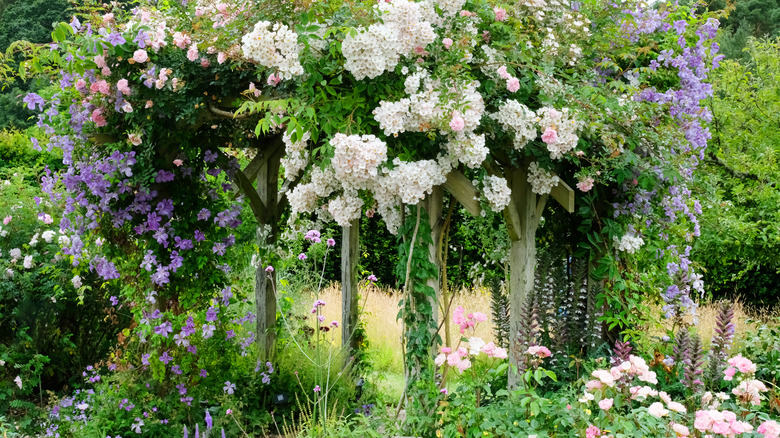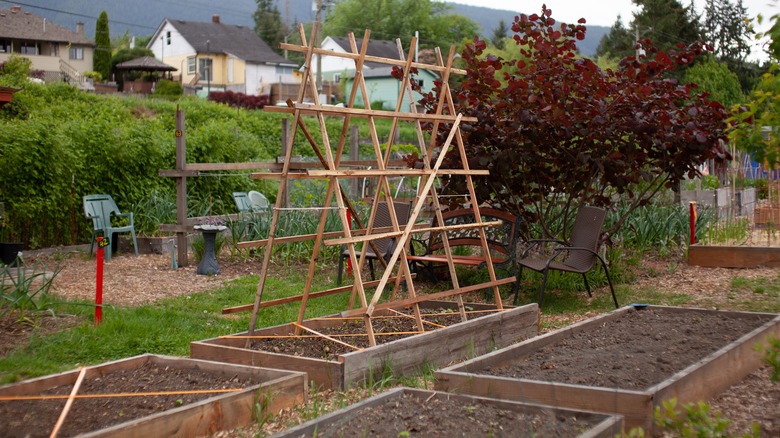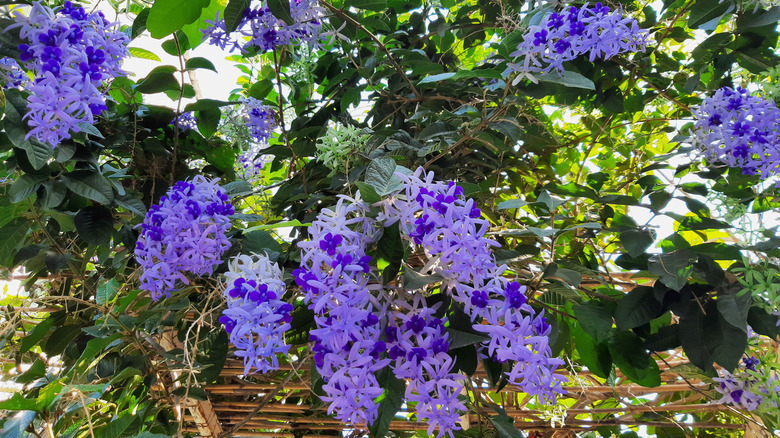The Stunning Climbing Vine That Will Fill Your Trellis Garden With Tropical Flowers
Try as you might, resisting the charms of Wisteria vines is an enormous ask in any gardening playbook. Donning drooping racemes of fragrant purple flowers, it has seduced droves of bees, hummingbirds, and butterflies, creating a pollinator haven like no other. Yet, to much chagrin, the exotic beauty slips past its ordained boundaries, fighting off native vegetation. It has been kicked off the planting list in certain areas of the southeastern U.S. and is an invasive vine you should know about. Fortunately, all hope isn't lost, for you can enjoy a similar-looking climbing vine sans the prolific spreading. Enter: Queen's wreath (Petrea volubilis).
Endemic in the Caribbean and parts of central to South America, Queen's wreath has scored a cult following for its pleasing, tropical appearance. Aglow in stunning shades of lavender due to its starry flowers huddling (like grapes) along the foot-long, wisteria-esque inflorescence, it looks breathtaking in a garden. Although some train it as a "standard" wherein the stems are arranged to mimic a tree, Queen's wreath works best to fill a trellis garden, considering its inherent twining nature. If you'd much rather grow white flowers, look for its "Albaflora" cultivar.
Deck your trellis in tropical flowers
Like all vines, Petrea is more anxious about growing tall — hence the quick growth — than creating a strong stem support system. That's why you should use a trellis to give your plants support unless you want the ground carpeted in arborescent skin. Fences, hanging baskets, pergolas, and lattices work, too, if your garden is missing a trellis. This ensures you get the perfect view of the profuse floral display the Queen puts out from early spring through summer. Indeed, so gracious is she that she produces small flower clusters intermittently, even in the fall and early winter. Unsurprisingly, this turns your yard into a bird haven, as hummingbirds zap around the exquisite bracts, as do bees and butterflies.
To boot, Queen's wreath's bluish-purple calyces (flowers' outer covering) take on the baton to prolong the show by staying behind when the flowers are long gone. Juxtaposed with the gritty, almost 9 inches long, verdant foliage, earning the climbing vine its "Sandpaper Vine" moniker, the calyces slowly turn a pallid gray, eventually dropping out. Afterward, their semi-evergreen, elliptic leaves maintain winter interest, except in colder regions where they're shed after frost.
Growing and caring for Queen's wreath
Well-adapted in USDA zones 10 to 11, Queen's wreath can be grown in 9b, provided the temperatures don't dip below 30 degrees Fahrenheit. Otherwise, they must be overwintered indoors. Also, they're best grown using air layers or cuttings. This is because they go to seed occasionally, and when they do, the seeds take their sweet time to germinate, thus delaying flowering by many years. Petrea plants are partial to well-draining soils, but their moderate salt resistance makes them a good-to-have alternative around coastal sites. They thrive on alkaline substrates, too.
To watch the flower-dripping vine reach for the sky — in other words, grow to its mature height of 12 inches — plant it in full sun. While semi-shaded spots aren't a problem, the blooms won't be as vibrant. Although Sandpaper Vine is considered drought-tolerant, it'll need frequent irrigation in the initial years until it establishes itself fully. Water only when the soil feels dry to the touch. That being said, you can't leave the clamberer to its devices, as it can grow top-heavy over the years while looking sparse and gangly below. So, shortly after planting the vine, guide its stems laterally along the trellis and knit them together through the gaps for a fuller look. Once the climber reaches the top, train the extra length down the trellis instead of pruning to keep its head from turning bushy.


